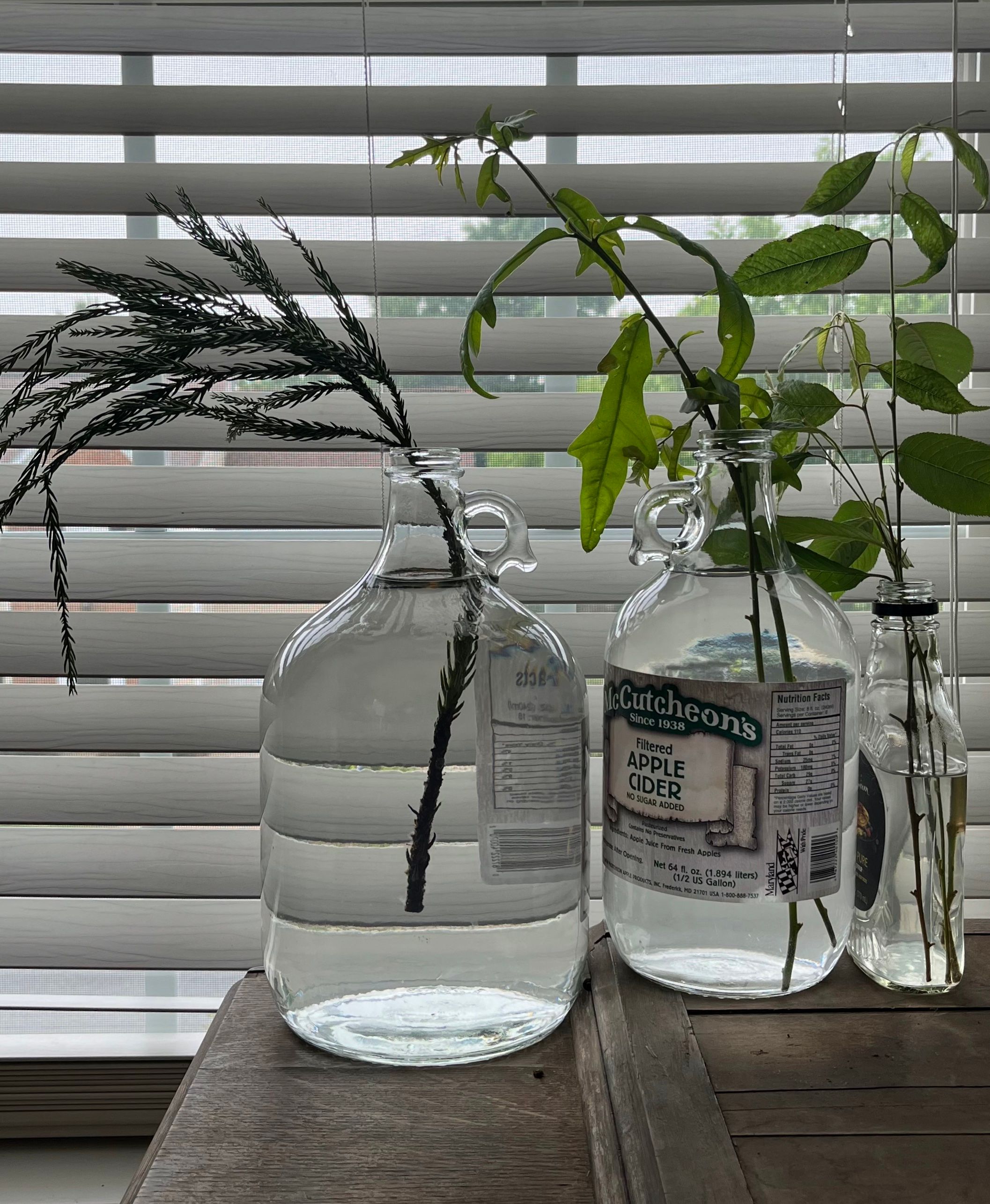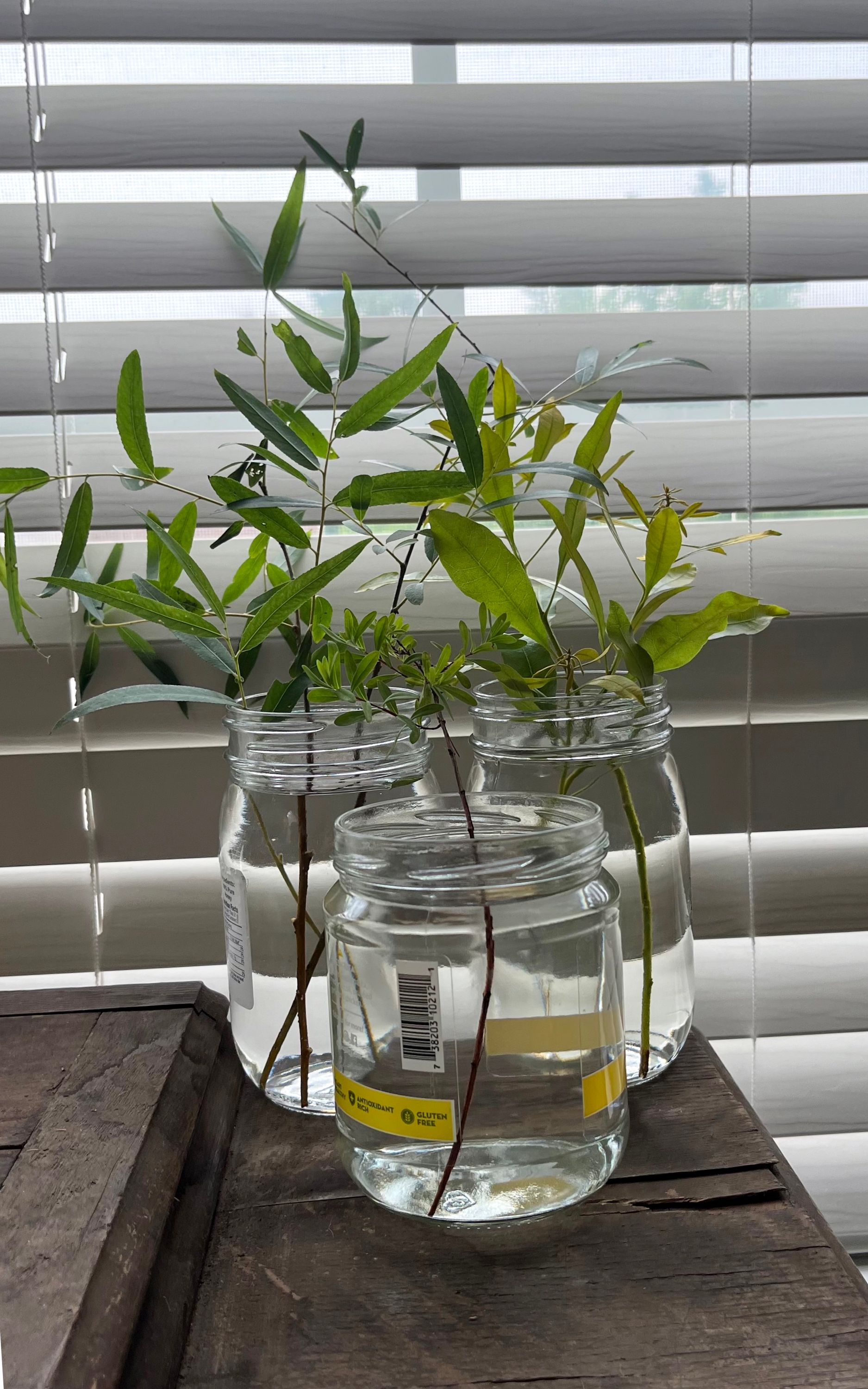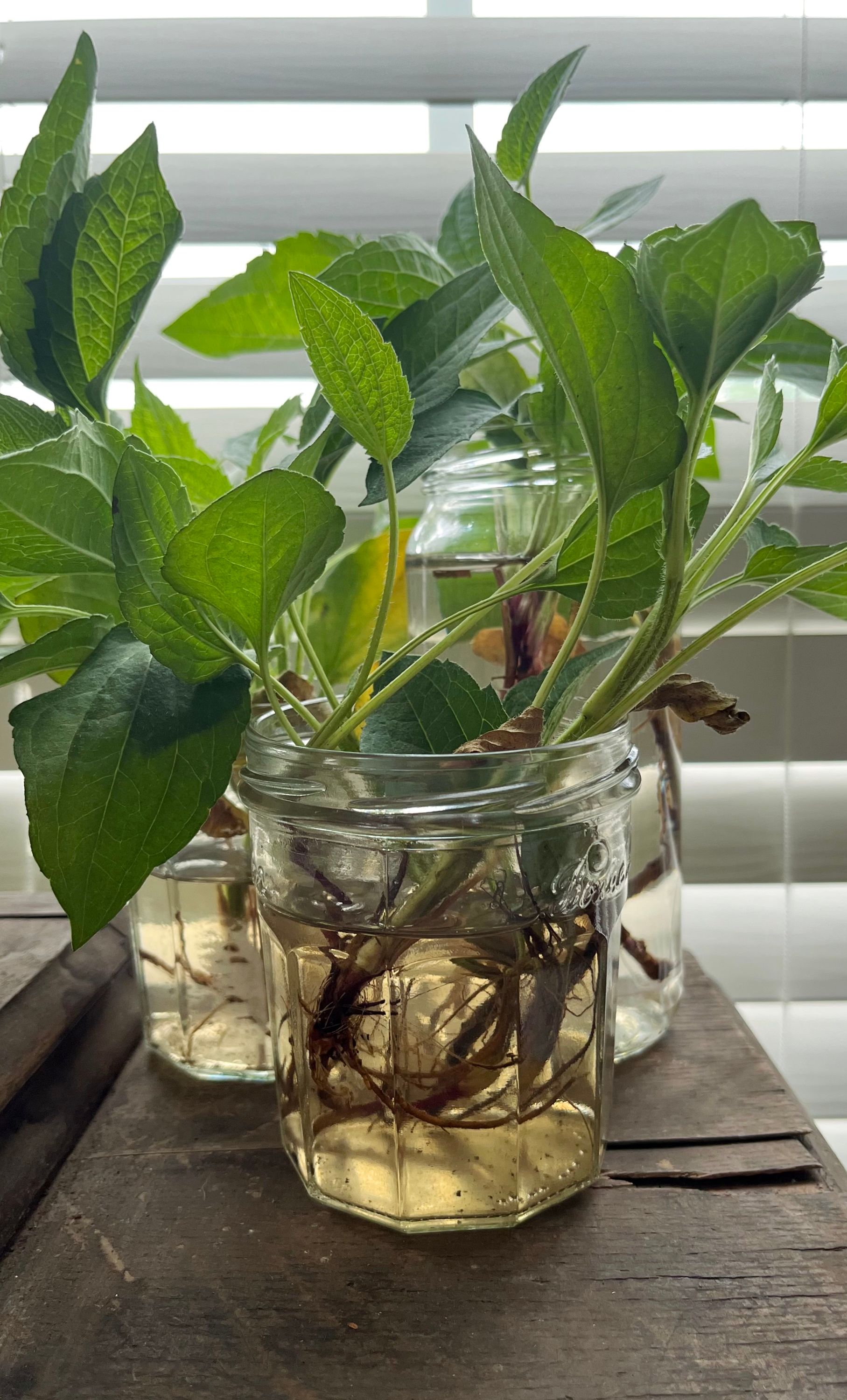Drying Daffodils
I’ve always been interested in crafts. From making paper ornaments in elementary school to learning to knit or crochet or sew to joining a robotics team where I learned the basics of working with metal, give me a handicraft of some kind, and I will pick it up, play with the tools, and learn as much as my brain can handle. Now, this presents some problems; my home is not a TARDIS, so I literally cannot pick up any brand new craft skills at the moment.
But I stumbled upon a craft that requires me to buy no more tools or materials, to take up no more space, or to give up more than a little bit of time.
Foraging for food is something that’s become a bit more mainstream these days. People will understand if you tell them you forage for mushrooms or for berries one your hikes. Obviously that is the simplest form of food foraging, but it’s an entry point. I know some people forage for leaf mold for their gardens, or for branches for firewood. I hadn’t heard of foraging for natural fibers until a year ago.
I discovered a woman on Instagram under the handle @foragedfibres who was going out into her local countryside to collect everything from willow stems to English ivy vines to spruce bark to create little woven baskets or pouches. Since I discovered her feed, her small baskets have grown, and she’s expanded beyond twisting fibers to other similar pursuits.
It was a few months ago, right around the time my own daffodils had popped up and started spreading their springtime cheer, that I saw a Reel Suzie had made explaining how to collect spent daffodil stems, dry them, and then turn them into cordage. I thought, I could do that, no problem. So I did. When the daffodils were done flowering, I snipped the stems back to their bases and brought them inside, strung them up, and hung them from my accordion peg rack in my office. There they have sat for well over three months as they finished drying, waiting for my attention to come back round. They’re still a bit off from being completely dry, but as soon as they are, I’ll follow Suzie’s instructions on how to turn them into cordage, and I think I’ll start a found-fiber basket. Maybe in time I can bring it with me when I go for walks in the morning and use it to collect some more gifts from nature that can spend some time in my office with me before I put them to use. In the meantime, I’ll keep my eye on the raspberries in my backyard, and the invasive ivy on my morning walks, judging when we both might be ready to try some more crafting.
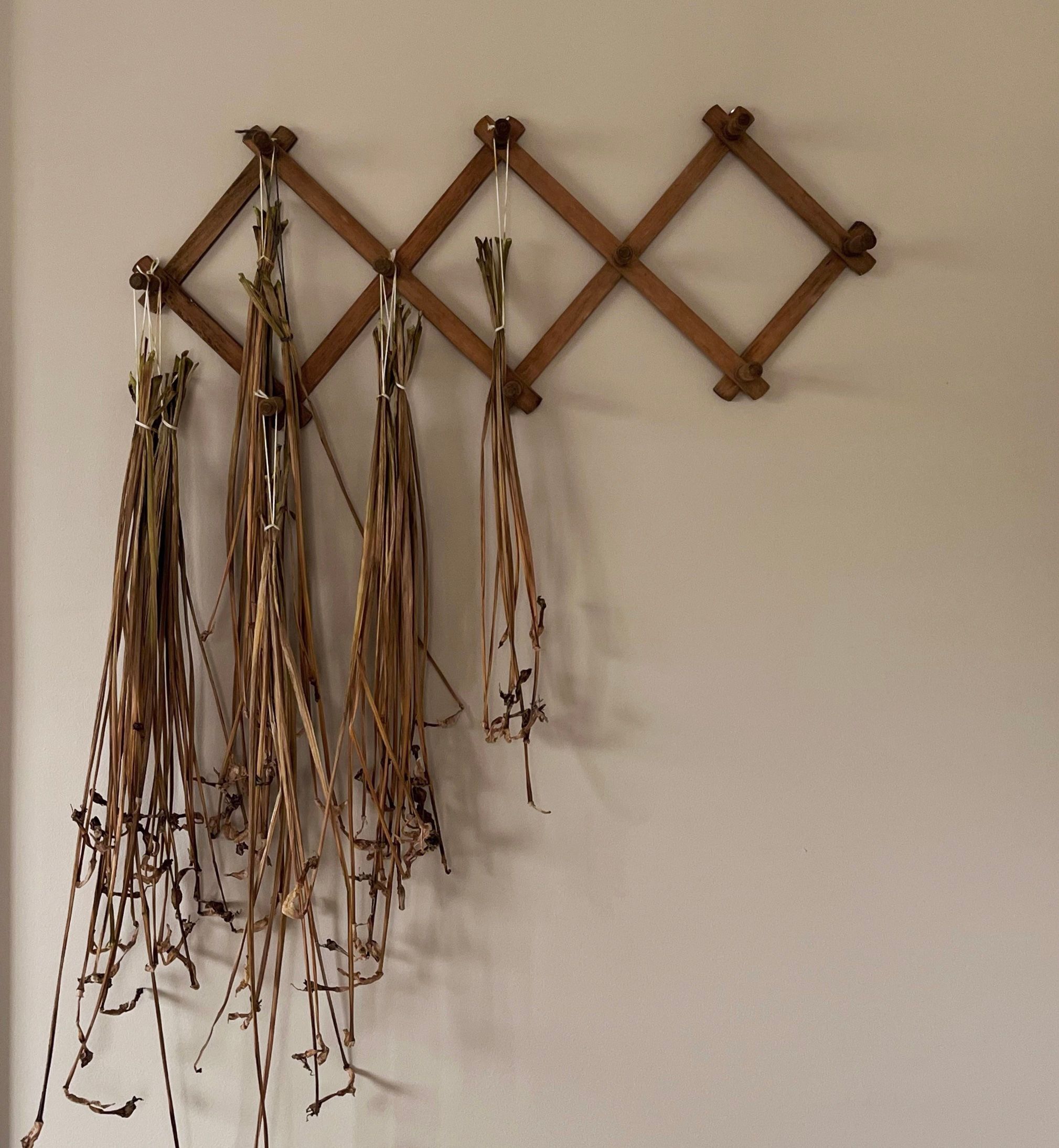 Daffodil stems drying in my office
Daffodil stems drying in my office
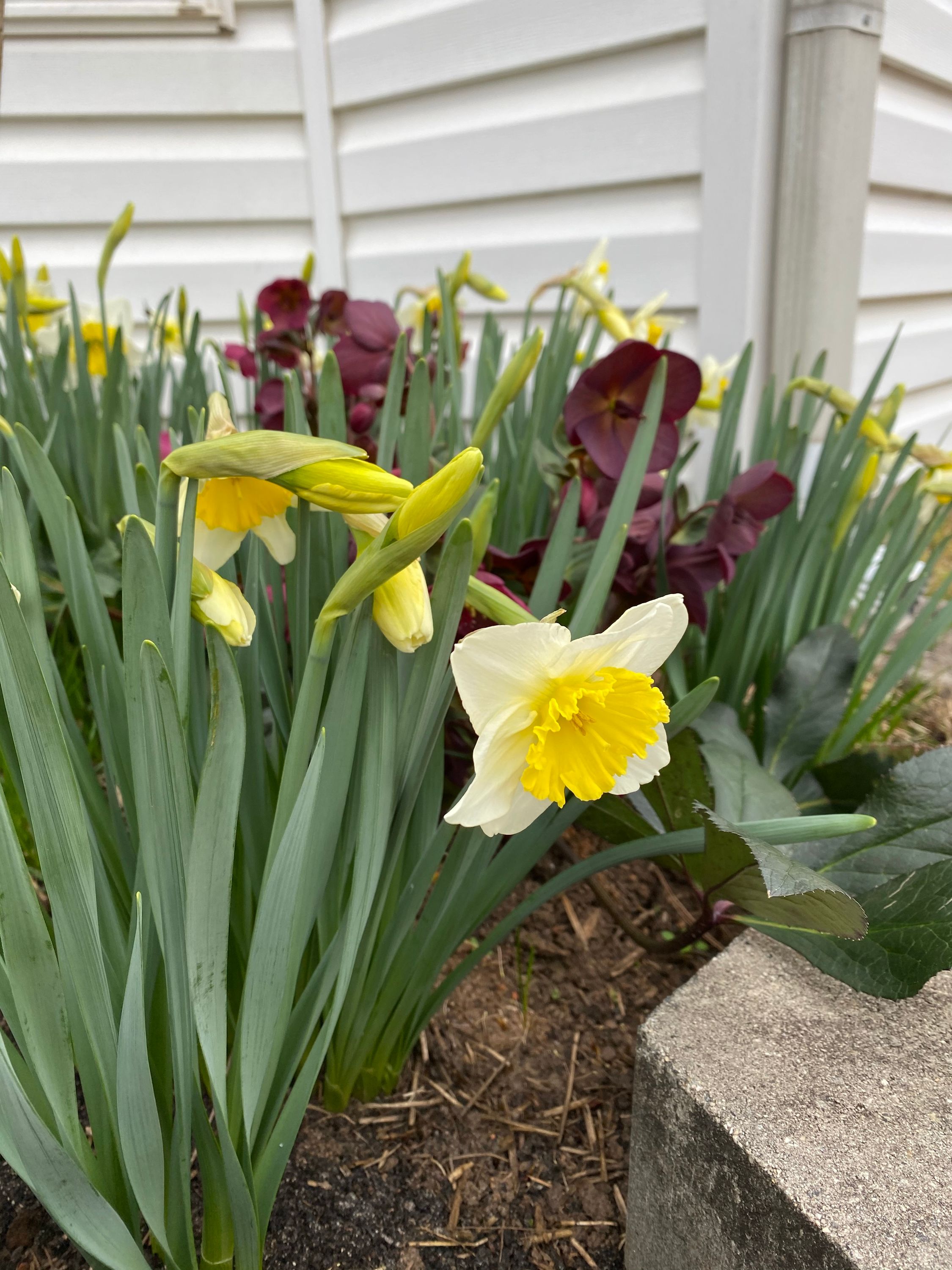 Daffodils in bloom in March
Daffodils in bloom in March
10 June 2022
creativity
fiber-crafts
Digital Boundaries
A few years ago, I read the book Digital Minimalism by Cal Newport. It was long enough ago that I can’t speak to the writing or the methods suggested in it with any confidence, but the fact that it was more than three years ago speaks to something that I’ve been struggling with for a long time: how much time do I spend on my phone?
 Screen Crime Stats
Screen Crime Stats
The answer, according to Screen Time on my iPhone, is about 7 hours a day. SEVEN HOURS. There is a reason why my friends and I have begun to use the term “Screen Crimes” for this data. The saddest part is that it used to be worse. In early 2021, I regularly hit 12 hours on my phone a day. Why? What was I doing on there?
Mostly, social apps like Instagram were pulling me in and refusing to let me go. Discord was a main culprit, too, but that was fine, I reasoned, because I was making friends, running a business out of a server, playing creative games like Dungeons & Dragons, learning about the world. There were days when I somehow managed to read for four hours without realizing. That seemed okay, too… until I realized that a lot of those hours were being spent while I was less than 3 feet from my partner.
I’ve tried many strategies to reduce my phone usage, but something always seems to pull me in; I mean, that’s what the apps are designed to do, so it makes sense. Lately, however, I wanted to try again, and try something else.
The first change was something seemingly small, but it’s had a big impact. I started going upstairs after dinner, changing into my loungewear, and plugging my phone in to charge. I go back downstairs to enjoy a movie or a tv show with my partner without my phone. If I need to do something with my hands–which is true 99% of the time–I pick up some embroidery, or maybe it’s a mending project, sometimes it’s a book if we’re watching hockey or another sport.
This managed to reduce my phone time by 2 hours on its own and it helped me wrap up a few outstanding projects. There’s room for improvement–sometimes I forget to bring my phone upstairs and I catch myself checking it–but it’s good progress.
The second change I made was add a single Screen Time limit for Instagram. During the week, I give myself 15 minutes, on weekends I get an hour. Now, Screen Time limits aren’t perfect. You can get past them by adding one minute, or fifteen, or ignoring the limit for the day. I’d say its got about a 75% success rate of pulling me out of the Reels spiral though. It’s just jarring enough that I think “Wow that was 15 minutes? Okay better do something else.” This has helped a decent amount, though I’m not sure how many hours I’ve clawed back because of it–I just don’t have the data.
Future ideas include quarantining activities to certain devices or areas of the house. I’ve been eyeing an iPad mini for a while. If I were to get one, it would immediately become the sole device that had access to Instagram and the games I still keep on my phone. I don’t want to get rid of either of those activities completely, but I want to consciously choose to do them. Similarly, I’m beginning to transition to using my Kindle or paper books only for reading. No more Kindle app on my phone. Reading is good, but if I intend to read, I don’t want to be doing it in snatches, hunched over my desk when I could be working.
I think I may also set up a charging station for my phone away from my bedside table. I don’t use it for an alarm, and using it to wind down before I fall asleep is not a good habit. If it’s charging across the room or even in my office, that’ll be better.
As I come up with other strategies that work for me, I’ll be sure to share them!
8 June 2022
strategies
books
Isolating Myself Through Difficult Times
Humans, in general, are pretty good at coming up with coping strategies for nearly any situation. Whether those coping strategies are healthy is another matter entirely. I noticed, recently, that one of my coping strategies for stress is so exactly the wrong thing, I will never understand how it became part of my tool kit at all.
When I am stressed, I am usually feeling intense overwhelm; my brain feels scattered, I fidget endlessly, and I make lists and lists and lists of things that must happen that instant (even though 95% of them don’t need to). One other thing I do is pull away from my friends. It’s not conscious, it’s not planned, but it does happen. I will feel so overwhelmed that I can’t answer a text, or I won’t pop into my favorite discords for a few days, or I will only react to friend’s messages instead of actually having a conversation.
On the surface, this tactic makes sense: if I have so much in my brain that a two-sentence text feels overwhelming, taking a step back from the text conversations seems logical. Taking a break from social media is sometimes the answer… but all of my favorite discord servers are small, contained places where my best friends from around the world are telling jokes and supporting each other 24/7–it’s not as if it’s the equivalent to falling into the Reels section of Instagram and never coming out (which, incidentally, is something I find myself doing when I’m overwhelmed… which is also not a great idea).
The fact of the matter is, if I texted my friends back and then took the time to tell them what was happening in my brain, they’d be the first to tell me that my big, long list of “must dos” is actually only 1 or 2 tasks. Or they’d be there to commiserate and offer advice about whatever work issue is stressing me out. The same goes for my discord communities–the few dozen friends scattered around the world are awake at any moment of my 24-hour day (which means that birthday celebrations in our collective timezone last nearly 42 hours) and we’ve all helped each other through our worst times and celebrated each other in our best.
So why do I pull back? What makes me hide my struggles? I won’t go into the psychological reasons, but I do remember that I started picking up this coping strategy when I was a teenager. If I had too much homework to complete and felt at the end of my tether, I hid that from my friends and family. I would pretend everything was great, and then stay up until 3am in the harsh light of my closet, alternating between crashing into snatches of sleep and furious attempts at completing one more calculus problem or one more page of biology homework. I would tell my friends I couldn’t go to the movies, or I couldn’t go hang out on the community pier, but I’d sit at home and stress, and I wouldn’t touch my homework until the house had quieted and I could hide in my closet and try to hold myself together.
Why am I telling you this? Because I want to stop doing that. I don’t hide my struggles behind closed doors and the dark of the night anymore, but I do stop talking about them. I fade quietly away until I don’t post things to my Instagram stories, or I stop writing blog posts, or I neglect to answer a text message or seven. It’s not what I need anymore. It was never what I needed.
Are you hiding, too?
6 June 2022
mental-health
Creativity in Dungeons & Dragons
A little less than a year ago, I joined my first Dungeons and Dragons group. Up until that time, I’d never been interested, but some friends asked me to play, and I thought, why not, I can always stop if I don’t like it.
After setting up my first character, Nala, and getting hooked into my DM’s fascinating world, things escalated quite quickly. I went from being in one play-by-post game (wherein the game is played in text form), to being in four. Then I created a fifth character for some one-shot style live games. He fell into some trouble, so I ended up with a sixth to play while he got out of a Dread Realm with his compatriots. I had the opportunity to DM and started building my own campaign in my own world; that got put on the back burner due to time constraints, but I still had the energy to say yes when a player-versus-player gladiator death-match game was proposed. Empyrean, my seventh character, didn’t win the match, but that’s okay, I have higher hopes for my eighth character–Lind–in the second round.
Needless to say, I clearly like it. In fact, I fell in love with it, and can safely say some of my favorite memories have already been created while playing. So why did it hook me? Besides the amazing friends, I truly think that I am addicted to the game because of one main thing: the creativity.
My usual creative outlets are single-person: knitting, sewing, writing, painting, even gardening. They rely on only what I can pull out of my own imagination. In Dungeons and Dragons, the world and the characters are built and explored collaboratively, with everyone pooling their imagination to come up with solutions to new problems the DM has thrown our way, or playing off of each other’s characters in a way you can’t recreate on your own. Add in the element of luck with the rolling of dice and you have a recipe for unexpected twists and turns, like, say, a bear-shifter proficient in athletics failing three times to climb over a waist high fence–I have never laughed so hard in my life about a damn fence.
It occurs to me that the last time I had any collaborative creative outlets, I was in middle school, working on a team project, or maybe it was playing games of imagination with my friends as we ran wild around our neighborhood in our younger years. Dungeons and Dragons let me experience that again, and I have to say, it makes me want more. I am soaking up the creative time with creative people, and in the back of my mind, a little voice is saying, now, how do we make this happen at other times.
I’ve got a couple ideas–collaborative writing exercises, or sending a free form art piece around to a group of friends–that I’m hoping to try, but I think the one I’m most excited for is returning to the world I was building to run my own campaign, and see where my players take me.
3 June 2022
dnd
rpg
games
creativity
Above the Mess Episode 15: Exist for a While
 Above the Mess Logo
Above the Mess Logo
We talk about returning to abandoned systems, garden projects, careers vs callings, and hacking into ice-protected servers.
Listen to Episode 15
1 June 2022
above-the-mess
podcast
Propagating Native Plants
For the last few months, I’ve been doing something that brings me great joy: removing invasive plants from my local woodland. It started small; I brought a pair of garden shears when I walked Jinx–she doesn’t require constant vigilance–and I snipped back an encroaching thorny bush at the edge of the walking path. I had no idea what the bush was, or I wouldn’t have bothered with just chopping branches; I would’ve gone whole hog and ripped the thing out of the ground. Little did I know I’d just pruned back a multiflora rose, one of the most invasive plants in North America.
Time passed, I started learning the names of plants, becoming fascinated by the native plants I saw–Philadelphia fleabane, Virginia creeper, willow oak, black cherries, greenbriar–and confused by the sheer number of plants that were not. Surely, I thought, a little untouched woodland shouldn’t be overflowing with kudzu, Japanese honeysuckle, thorny olive, and Chinese privet? Of course the evidence otherwise was right in front of me.
 Native Cuttings
Native Cuttings
My work in removing the invasives led me to realize that if I was going to keep pulling plants out, I would need to put plants back in to cover the ground I’d just laid bare. Given that I’m doing this work in brief snatches of time before I log on to my day job, I decided that rather that go out shopping for seeds and plants, I could do something easier: I could take cuttings.
 Willow Oak, Sugar Hackberry, Muscadine
Willow Oak, Sugar Hackberry, Muscadine  River Birch, Prunus variety (non-native), Milkweed, Garden Phlox
River Birch, Prunus variety (non-native), Milkweed, Garden Phlox
Taking a cutting is exactly what it sounds like. I took a pair of snips to any plant I wanted to propagate, and cut off a small branch or two. I did this in the wilder parts of my backyard, in the woodland itself, and in my front garden. So far, I’ve amassed a collection. They’re sitting in a window of my office in jars of clean water, letting the sun drench their leaves, and working on growing roots. A few haven’t made it, but the rest are doing great, and when they put out enough roots, I’ll pot them up, get them used to the weather outside, and settle them in their new home, giving nature a helping hand.
If you want to do this yourself, I encourage you to start! I use an app called Seek by iNaturalist to identify the plants in my area, and before I take a cutting, I ask the plant in question if it wouldn’t mind. It might seem odd, but it’s something I learned from reading Braiding Sweetgrass by Robin Wall Kimmerer. Consent, even from plants, is key. If a plant in your area is struggling, taking a cutting would be like kicking it when it’s down, but if it’s flourishing and sending out suckers or shoots every which way, it may be telling you that it can take it.
When I get home, I prepare the cutting for propagating by making sure I have a good-sized glass jar and some filtered water, remove the lower 2/3rds of the cuttings foliage or branches, and pop it right on in there. The plant community is divided on whether to give your cutting sunlight or not. I keep mine out of direct sunlight, but I don’t stuff it in a dark corner. Every few days, I check to see if any of the jars need a topping up or completely fresh water. Sometimes, a cutting will perish. That’s okay, it just wasn’t meant to be. Every plant will be different, believe me.
The rest is just patience. First there will be one root, then two, then a dozen. It’s around that time that I will remove the cutting from the jar, find a pot somewhere in the house (usually a plastic one from the nursery that I’m reusing for the umpteenth time), and pot the cutting up with either a seedling mix or a generic potting mix. I’ll then put it back, give it some water and a week or two, then wait for a cloudy day–so it’s not a billion degrees–and bring it outside to find it a home.
Try to find each plant a spot similar to its original location. For example, I took a cutting from a muscadine vine that was growing in the acidic soil beneath a dozen pine trees. I won’t plant that out in full sun in a spot that doesn’t get a healthy dose of pine needle mulch every year–it wouldn’t love it. The opposite would be true for the Black-eyed Susans; they are in a rich loamy soil right now, so I’ll be finding them the edge of a small prairie when they’re ready to go out.
I’m so excited to get these plants back in the ground, but for now, they’ll keep me company as I do my daily work.
30 May 2022
native-plants
projects
plants
Above the Mess Episode 14: Not Qualified to Talk About Any of It
 Above the Mess Logo
Above the Mess Logo
We talk about a world built for everyone, spider mites, and eating raw potatoes.
Listen to Episode 14
18 May 2022
above-the-mess
podcast
Above the Mess Episode 13: It’s Not a Good Mess
 Above the Mess Logo
Above the Mess Logo
We talk about travel, global temperature change, water rodents, and body hacking.
Listen to Episode 13
4 May 2022
above-the-mess
podcast
Above the Mess Episode 12: Do What You Can
 Above the Mess Logo
Above the Mess Logo
We talk about the end of the world, carbon footprints, and To Be Read lists.
Listen to Episode 12
20 April 2022
above-the-mess
podcast
Above the Mess Episode 11: I Don’t Even Remember
 Above the Mess Logo
Above the Mess Logo
We talk about Magic: The Gathering, organization object permanence, the Shakers, and more journals.
Listen to Episode 11
7 April 2022
above-the-mess
podcast
 Daffodil stems drying in my office
Daffodil stems drying in my office Daffodils in bloom in March
Daffodils in bloom in March



